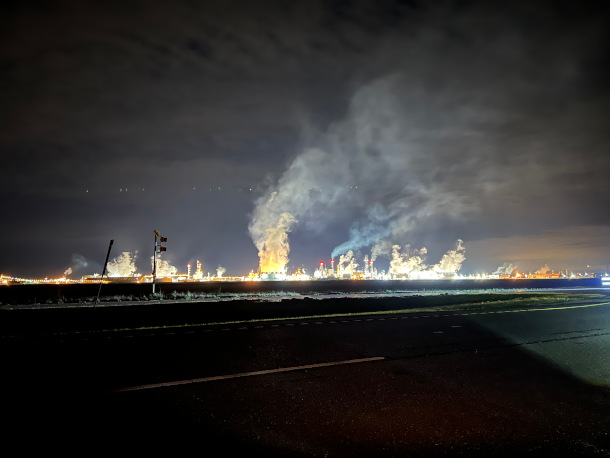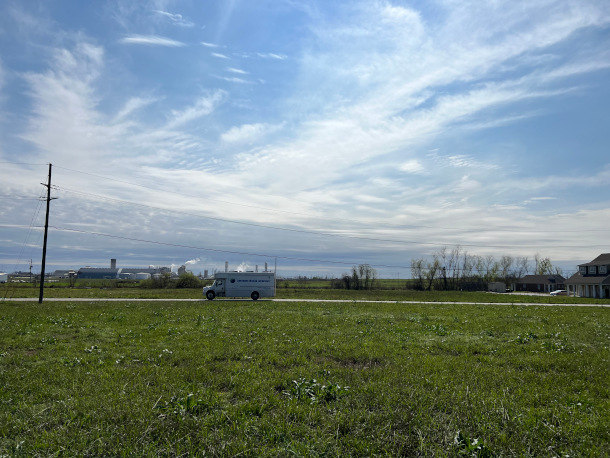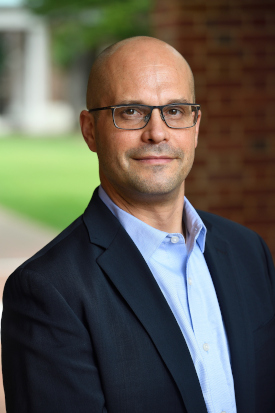New Tech Finds More Cancer Risk
Air Date: Week of July 12, 2024

Johns Hopkins University researchers studied ethylene oxide across Louisiana's petrochemical corridor. Companies often resort to venting or flaring (pictured above) where gas is burned as a safety measure. Venting and flaring of petrochemical plants are seen as a significant source of gas waste and toxic chemical emissions. (Photo: Peter DeCarlo)
New technology reveals startling levels of cancer-causing ethylene oxide gas wafting from industrial sources in Cancer Alley, Louisiana. Peter DeCarlo of Johns Hopkins University led the research and joins Host Jenni Doering to explain the findings and the health risks for residents.
Transcript
O’NEILL: It’s Living on Earth, I’m Aynsley O’Neill.
DOERING: And I’m Jenni Doering.
The eighty-five-mile stretch of the Mississippi River between Baton Rouge and New Orleans is known as “Cancer Alley” because communities there experience the highest risk of cancer from industrial air pollution in the United States. And a major source of that risk comes from facilities that emit ethylene oxide, a colorless, sweet-smelling gas used in sterilizing medical equipment. Exposure to that chemical is linked to lymphoma, leukemia, and breast cancer. In March the US Environmental Protection Agency finalized rules that will soon require industry to install pollution controls that would reduce ethylene oxide emissions by about 90 percent. Still, new research suggests even those reductions may fall short of what’s needed. Environmental engineers from Johns Hopkins University found that ethylene oxide was present in Cancer Alley at levels far higher than what is considered safe. Joining me now is senior author of the paper Peter DeCarlo, associate professor at Johns Hopkins. Welcome to Living on Earth Peter!
DECARLO: Thank you for having me.
DOERING: So what kinds of numbers are we talking about? Can you paint us a picture here?
DECARLO: Eleven parts per trillion is the level of ethylene oxide associated with a one in 10,000 chance of getting cancer over a lifetime of exposure. Just to put that in context, 11 parts per trillion is 11 molecules of ethylene oxide per trillion molecules of air, which is really small. When we think about ozone pollution in the summertime, we're in parts per billion, which is a thousand times higher than that. And when we think about climate change, and CO2, we're a million times higher than that. So we're talking about really, really small concentrations of ethylene oxide, and the levels that we saw exceeded that 11 parts per trillion value, which indicates higher than one in 10,000 chance of getting cancer over a lifetime of exposure.

The mobile laboratory or “lab on wheels” that Johns Hopkins researchers used to measure ethylene oxide across a section of Louisiana. (Photo: Peter DeCarlo)
DOERING: So what kinds of levels were you seeing in the research that you conducted?
DECARLO: The concentrations at the census tract level, got up to over 50 parts per trillion, which is over five times that kind of safe, I wouldn't even call it safe, it's the limit of what's allowed at a cleaned up Superfund site. So when you clean up a very toxic site, the kind of maximum allowable risk is one in 10,000, cancer risk. And we were above that, for pretty much the entirety of our study area. At the fence line, occasionally, we would see levels that got even 1000 times higher than that. And that these are direct emissions from these facilities, they're plumes that are kind of coming across fence lines in the air. And we're seeing concentrations in the 10 to 40 parts per billion range, which again, is 1000 times higher than that parts per trillion level that we're talking about. And we certainly were able to identify plumes of ethylene oxide up to 10 kilometers or more away from these facilities. So this stuff travels with the air.
DOERING: So what are the dangers associated with long term exposure of this chemical?
DECARLO: So ethylene oxide is a carcinogen. It's an mutagen, which means it affects our DNA. So the molecule will impact our DNA and increase the likelihood that we get cancer. And I just want to point out that it's that same method of action is why it's a really good chemical sterilizer. So it's used for sterilizing medical equipment, and to kill all the bacteria and viruses that may be on that.
DOERING: So how exactly is this chemical getting out into the surrounding air?
DECARLO: So some of that is probably coming out through leaks in pipes or tubing that was moving the gas from one place to another on these facilities, we did see an association, often with increased levels of carbon dioxide. When you see carbon dioxide in the air, it usually means there's some kind of combustion, so it could be associated with a combustion event or occurrence. So if they're trying to flare or burn up ethylene oxide, as it gets vented, or exhausted, that would lead to higher concentrations of both ethylene oxide and carbon dioxide. So it's not clear we weren't on the sites themselves, making measurements on each piece of equipment we weren't allowed to be. And so what we were able to do was drive around these facilities and around the fence line, and try to get an idea of of what was coming out and seeing associated other chemicals with that helps give clues on what processes maybe emitting the ethylene oxide.
DOERING: So from what I understand the sampling that you used for the study is pretty different from what's previously been used to track ethylene oxide. What was different about your research methods?

Medical devices that require ethylene oxide (EtO) sterilization include heart valves, pacemakers, surgical kits, gowns, drapes, ventilators, syringes, and catheters (shown above). (Photo: Thirteen of Clubs, Flickr, CC BY-SA 2.0)
DECARLO: So in 2018, EPA changed the risk values for ethylene oxide, and they reduce them pretty substantially. And along with that, there came a recognition that the current methods of measuring ethylene oxide were not sufficient to get to the levels needed this 11 part per trillion level, we need to understand kind of risk at the community level or the background level. The other really important thing to note is that the current measurement technology that has been used for a while by EPA has been shown to have what's known as artifacts. And what they were doing in the sampling technique is you take a stainless steel canister and you pull air into it, you take that back to the lab and you make a measurement. There have been now acknowledged problems with that methodology, leading to uncertainty in the concentrations of ethylene oxide measured. And so it seems to be that storage in the container led to some reactions that increase the concentration of ethylene oxide or did something to make it so that the ethylene oxide wasn't accurate. And so along with that ruling came the need for new technology to measure ethylene oxide quickly and at these concentrations. And two of the instruments that we had along with us in Louisiana, were born from that need for new technology. So the other really cool thing about what we were doing down there is we took these brand new instrument technologies and we put them in a mobile lab. And so a mobile lab is essentially lab on wheels, there's a generator on the back of the mobile lab or a large battery pack to power instrumentation as we drive around. And this really sensitive brand new instrumentation is making measurements at about one measurement per second, which allows us to get really detailed spatial resolution. And just to give you some perspective on that, when you're driving about 30 miles an hour, one second data is about a 10 meter resolution. So we're getting about 10 meter resolution as we drive along with this new technology making measurements of ethylene oxide.
DOERING: So to what extent do you think that the different methodology could be accounting for the fact that you were able to find levels much higher than EPA thought the concentrations of ethylene oxide were in this area?
DECARLO: So I think the reason that our measurements exceeded the model values from EPA is that well, first of all, there are no measurements in that area to compare directly to. And so the modeling data was all we had to go on, those models rely on what's called the emission inventory. And the emission inventory is an annual emission report that's compiled usually at the state or local level, and then sent to EPA and aggregated into a national emissions inventory. So the state of Louisiana compiles the data from Louisiana, sends it to EPA, it goes into the emissions inventory. And then that forms the basis of the expected ethylene oxide emissions from facilities in Louisiana. Now, where this becomes a problem, is there's no accounting, there's no way to check that. And so the measurements that we did, were essentially a check of that. We look at the ambient levels, the air tox screening assessment gives us what they think the ambient level should be based on those emissions. And we saw this mismatch and a factor of five to 10, higher, in some cases, 20 times higher for the census track level concentrations of ethylene oxide.

Peter DeCarlo is an associate professor of environmental health and engineering at Johns Hopkins University. (Photo: Courtesy of Peter DeCarlo)
DOERING: Sounds like your research was filling a really huge gap here. I mean, if you know, we're relying on estimates for cancer risk, Estimates of how much ethylene oxide really potent carcinogen, is actually in the air in these communities. What does that mean for the risks that they're being exposed to?
DECARLO: That's a great question. I mean, I think the whole motivation for this project was to find a place where we identified the kind of highest density of ethylene oxide producing facilities, and go see what was there. Because we didn't have a lot of measurements, this technology did not exist up until a few years ago. And so we didn't have the ability to do this type of measurement. But also to be clear, the infrastructure nationally for measuring hazardous air pollutants is not as strong as the infrastructure measuring things like particulate matter, or NOx, or carbon monoxide. And so the hazardous air pollutants are a different category, they're much more difficult to measure and there's a lot fewer sites across the US measuring these hazardous air pollutants. So what we found in Louisiana isn't necessarily unique to Louisiana. It's unique in the sense that it's the highest concentration of these ethylene oxide producing plants. But the fact that we have to compare measured values to model values, because that's all we have to compare to is not unique. It's something that's pretty widespread across the US.
DOERING: Peter, I know you're a scientist but if you can reflect a little bit, what can communities do in cancer alley with this information?
DECARLO: Ideally, we want communities to be able to use this type of information to advocate for themselves. I'm not a resident of this area and so I think the conversation about what can be done really belongs with the people who live there, and the agencies that are tasked to protect them. But I think, you know, one potential option that is available is now that we have these numbers and these estimated cancer risks based on these numbers it's part of the conversation about- should you build any more facilities in an area that already is exceeding what's considered safe from a cleaned up Superfund site, right? If the cancer risk is higher than 1 in 10,000, then that's not good enough for a cleanedup superfund site that shouldn't be good enough for what's going on now. And there certainly shouldn't be any additional burden added to that area. And so I think community groups now have something that they can point to and say "we have a pretty high burden right now of environmental pollution, we don't need any more, and don't give us any more". And I think that's something that's valid that can come from this type of data.
DOERING: Peter DeCarlo is an Associate Professor of Environmental Health and engineering at Johns Hopkins University. Thanks so much for joining us.
DECARLO: Thank you for having me. It's been a pleasure.
Links
Read the study led by Johns Hopkins University on Ethylene Oxide Levels in Louisiana
The Guardian | “Air in Louisiana’s ‘Cancer Alley’ Likely More Toxic Than Previously Thought”
Living on Earth wants to hear from you!
Living on Earth
62 Calef Highway, Suite 212
Lee, NH 03861
Telephone: 617-287-4121
E-mail: comments@loe.org
Newsletter [Click here]
Donate to Living on Earth!
Living on Earth is an independent media program and relies entirely on contributions from listeners and institutions supporting public service. Please donate now to preserve an independent environmental voice.
NewsletterLiving on Earth offers a weekly delivery of the show's rundown to your mailbox. Sign up for our newsletter today!
 Sailors For The Sea: Be the change you want to sea.
Sailors For The Sea: Be the change you want to sea.
 The Grantham Foundation for the Protection of the Environment: Committed to protecting and improving the health of the global environment.
The Grantham Foundation for the Protection of the Environment: Committed to protecting and improving the health of the global environment.
 Contribute to Living on Earth and receive, as our gift to you, an archival print of one of Mark Seth Lender's extraordinary wildlife photographs. Follow the link to see Mark's current collection of photographs.
Contribute to Living on Earth and receive, as our gift to you, an archival print of one of Mark Seth Lender's extraordinary wildlife photographs. Follow the link to see Mark's current collection of photographs.
 Buy a signed copy of Mark Seth Lender's book Smeagull the Seagull & support Living on Earth
Buy a signed copy of Mark Seth Lender's book Smeagull the Seagull & support Living on Earth

